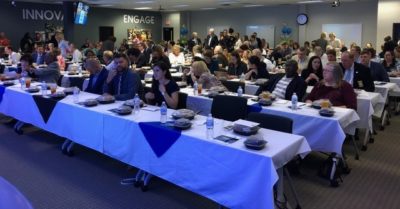
About 120 citizens filled a recent Rowan-Salisbury School Board meeting, asking the board not to demolish Overton Elementary School in Salisbury and asking them to build a K-8 school instead.
Overton’s campus is adjacent to Knox Middle School, with only athletic fields standing between them. Citizens asked the board to build the K-8 on the fields and allow both schools to continue uninterrupted during construction.
Among the speakers was Salisbury Mayor Al Heggins. Heggins, the first African-American woman elected to the post, reminded the board that many children at Overton come from challenging backgrounds. She reminded the board of all the times they have expected the children to “make do.”
“We have to think of the children first,” she said. “As public officials, that’s our job. Before we get caught up in brick and mortar, let’s be sure we think of flesh and bone and spirit.”
A total of 27 citizens spoke, all in favor of building a K-8 school at the site. The meeting room was so full that many had to go upstairs and watch the meeting on monitors. Speakers included retired Overton and Knox educators, parents, grandparents, and pastors from the community.
The coordinated action was prompted in part by a letter to the editor in the Salisbury Post from Elizabeth Trick, a local architect. In her remarks, Trick reminded the board of the ideal location of Overton Elementary. It’s situated on a dead-end road in a quiet, safe neighborhood, bounded by the greenway and a nature preserve, and in walking distance to Horizons Unlimited, a science center with a planetarium. It’s walkable and bikeable.
“As a parent of students at both Overton and Knox, I wrote the letter because I didn’t think it was right, and I’m angry. I’ve received emails from school board members, and I’ll just say I’m optimistic. I’m so pleased my letter inspired the community to come together and take action,” said Trick after the meeting.
Reverend Robert Black, rector at St. Luke’s Episcopal Church, reminded the board of the burdens of systemic racism.
“Our county’s motto is, ‘Be Original.’ There’s nothing original about closing a majority-minority school,” said Black.
Dr. Mary Frances Edens is a retired principal of Overton.
“For many of our children, school was a refuge from hunger and trauma. When students come from extreme poverty, we must provide more stability,” said Edens. “These buildings have been unsafe for education for many, many years. Keeping students together as a family, a K-8 will strengthen student resiliency. Keep the children in your heart and do what’s best for them.”
Pastor Anthony Smith from the Mission House church spoke of the Maasai tribe in Africa, who greet each other with the question, “How are the children?” Smith has two granddaughters at Overton and referred to the book, “Ghosts in the Schoolyard,” which explores the national trend of closing schools populated by children of color, particularly African-American children.
“What we know is, the impact of this history cannot be wished away, but must be intentionally dismantled at the board and county levels. Children impacted by trauma will be affected,” he said.
Other speakers mentioned that the three schools to which Overton students would be distributed all have “D” or “F” school performance grades. One said that concentrating poverty is not going to improve those grades.
The school board meeting agenda originally had two action items related to the issue: Knox student relocation and the Knox addition and renovations contract. Board chair Josh Wagner pulled both items from the agenda at the beginning of the meeting, saying the board was not successful in attaining a $10 million grant for construction of a South Rowan Elementary School, and that the board was not prepared to discuss going further.
Overton Elementary School is 56 years old but had a wing added about 15 years ago. Knox Middle School is 61 years old and has a six-building campus. It has more than 40 exterior doors, which many say create a security hazard.
Chris Bradshaw owns a third-generation construction firm in Salisbury. His father built Overton and Knox, and his grandfather built Salisbury High School. Bradshaw did not attend the meeting but had many thoughts on the issue because of his profession and his relation to the buildings.
“Salisbury High was built to last,” Bradshaw said. “Overton and Knox were not. If you plan to replace the mechanicals and roof on Knox, you’re going to run into trouble. When the roof comes off, you’ll likely find places where leaks have happened and the structure is compromised.”
In general, architects say that if the cost of rehab exceeds 50% of the replacement of a building, then rehab is not a cost-effective solution. Bradshaw wholeheartedly agrees.
“Overton is in better physical shape than Knox is, but we’re talking about tearing down Overton and trying to save the structure at Knox,” he said. “It makes no sense to me.”
The cost for building a new K-8 that would combine Knox and Overton was estimated to be $78 million. The cost of rehab is estimated at $26 million.
“We already own the land,” he noted, “and we have enough property to build between Overton and Knox. I don’t see what the problem is.”
Bradshaw attended Henderson Elementary School in Salisbury. At the time, it served grades 1-8. Bradshaw recalls eighth graders coming to read to his second grade class. It gave the teachers a break, he said, and helped both the second-graders and the eighth-graders. In his view, a K-8 school would be a positive structure for the community.
The school board may address the issue in December.
“The board will have a larger discussion moving forward about the Knox and SRES (South Rowan Elementary School) projects, Wagner said. “We need to be clear on the total cost of both projects before making a final plan for Knox.”


